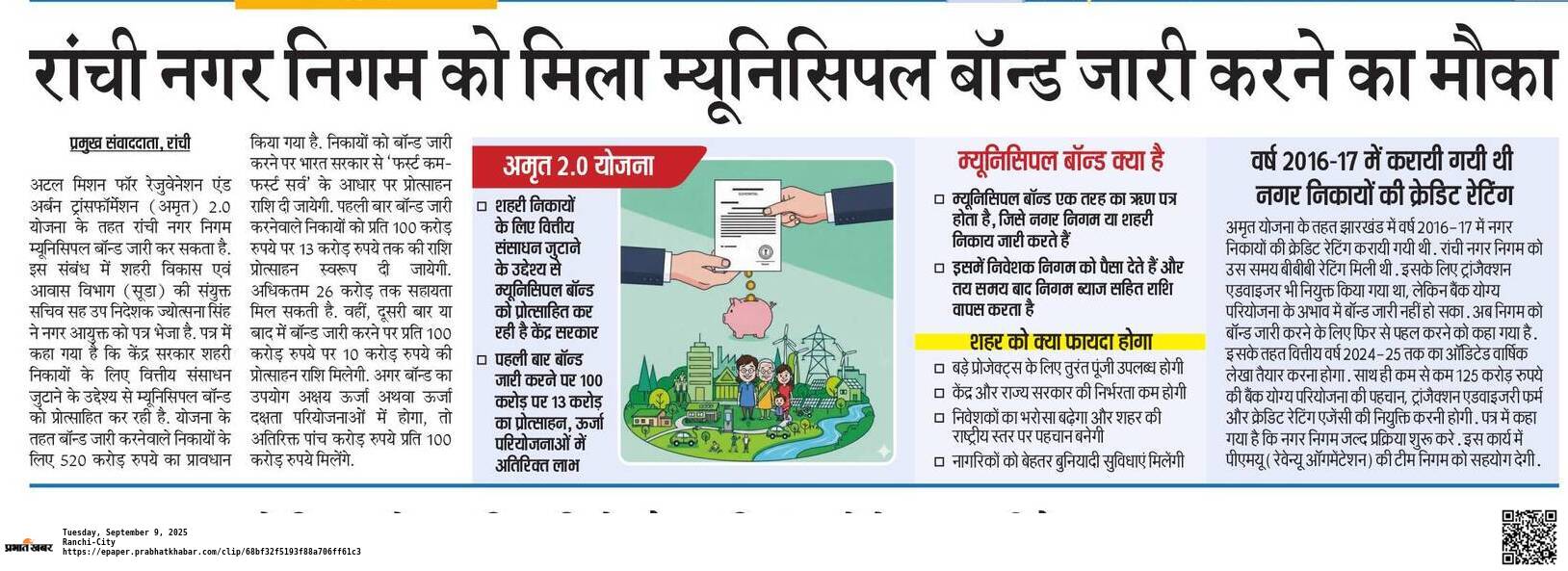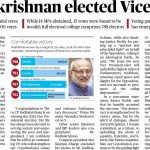Ranchi, the vibrant capital of Jharkhand, is poised for a significant milestone: Ranchi Municipal Corporation (RMC) has received official approval to issue a municipal bond under the AMRUT 2.0 scheme. This landmark move represents much more than a financial technique—it signals Ranchi’s entry into an elite group of Indian cities leveraging innovative urban finance for self-reliant growth.
What Are Municipal Bonds?
Municipal bonds are special debt instruments issued by Urban Local Bodies (ULBs)—essentially a way for cities to raise money directly from citizens, banks, or institutions for vital infrastructure projects.
-
How do they work? Investors buy the bonds, lending money to the city. The municipality returns the amount with interest after a set period.
-
Why are they attractive?
-
Tax benefits: Many offer tax exemptions on interest, making them ideal for regular investors.
-
Regulation: They are governed by SEBI, ensuring robust investor protection and transparency.
-
-
Global and Indian context:
-
Used globally for roads, water, and schools.
-
In India, Ahmedabad, Pune, Surat, Lucknow, and Hyderabad have set successful examples.
-
“When a city raises money directly from its people, it raises trust and accountability along with capital.”
Latest Developments: RMC’s Bold Step
Ranchi Gets the Green Light
-
🏙️ Approval Granted: RMC is now eligible to issue municipal bonds, thanks to a nod from the Urban Development and Housing Department (SUDA) under AMRUT 2.0.
-
💰 Incentive Boost: Under the central scheme, first-time issuers like RMC receive ₹13 crore for every ₹100 crore raised in bonds.
-
📊 Technical Checklist: RMC must prepare audited accounts for 2024–25, appoint advisory/credit rating agencies, and design a ₹125 crore bankable project.
The AMRUT 2.0 Advantage
Atal Mission for Rejuvenation and Urban Transformation (AMRUT) 2.0 is a flagship Government of India program to rejuvenate Indian cities through smart infrastructure and modern amenities.
-
Incentive Structure:
-
₹13 crore incentive per ₹100 crore raised (for first-time issuers)
-
National incentive pool: ₹520 crore
-
Bonuses for green and energy-efficient projects
-
-
Eligibility:
-
ULBs need audited accounts, positive net worth, and no defaults to qualify.
-
Fast-track bonuses reward early and green issuers.
-
Pull Quote: “AMRUT 2.0 is more than a mission—it’s a movement towards self-reliant, smart cities.”
Why Was Ranchi Chosen Now?
-
Improved governance: RMC has steadily enhanced transparency and administration.
-
SUDA support: This time, SUDA is actively guiding RMC through technical and financial prerequisites, a marked improvement over the failed attempt in 2016–17 (which faltered due to a BBB credit rating and lack of viable projects).
-
Commitment to compliance: RMC is focused on meeting all conditions—audited accounts, ratings, viable project designs.
Impact & Prospects for Ranchi
-
Expected Benefits
-
1. Speedier Infrastructure:
Rapid rollout of roads, water, sanitation, and renewable energy independent of state grants. -
2. Financial Autonomy:
Cities like Ranchi can plan and prioritize local projects more freely. -
3. Enhanced Services:
Improved transport, sanitation, and urban amenities for citizens. -
4. Citizen Engagement:
By investing in municipal bonds, locals become stakeholders in city-building. -
5. Economic Growth:
Infrastructure projects mean more jobs and a stimulated local economy. -
6. Support for Green Projects:
Financial rewards encourage eco-friendly and energy-efficient development.
Local Voices
A Ranchi businessman shares:
“If my investment helps build better drains and roads, it’s not just a return—it’s pride in my city’s progress.”
Challenges and Road Ahead
-
Investor Confidence: Clear communication and project viability are key to mobilizing funds.
-
Strict Financial Discipline:
Audited accounts and timely repayments will ensure future fundraising ability. -
Transparency:
Citizens will expect open, accessible reporting on how bond funds are used. -
Repayment Commitment:
Delays or defaults can ruin trust and dim future prospects.
Lessons from Other Cities
-
Ahmedabad (1998): First Indian city to launch municipal bonds.
-
Pune (2017): Raised ₹200 crore, demonstrating investor appetite.
-
Success factors: Strong projects, transparency, and community engagement.
📝 Exam-Ready Infographic: RMC Municipal Bond at a Glance
𝗤𝘂𝗶𝗰𝗸 𝗙𝗮𝗰𝘁𝘀
-
Municipal Bond: Debt instrument for ULB infrastructure funding.
-
Regulation: Governed by SEBI for safety and transparency.
-
Incentive:
-
₹13 crore per ₹100 crore raised under AMRUT 2.0 (first-time issuers)
-
Bonuses for green/energy projects
-
₹520 crore national pool
-
-
Eligibility: Audited accounts, positive net worth, no defaults.
-
RMC: Previously failed in 2016–17 (BBB rating). Now compliant with support from SUDA and new project pipeline.
𝗪𝗵𝘆 𝗜𝘁 𝗠𝗮𝘁𝘁𝗲𝗿𝘀
-
Decentralises city finances
-
Promotes transparency and civic investment
-
Strengthens local governance
-
Boosts jobs and urban services
-
Accelerates smart and sustainable growth
𝗞𝗲𝘆 𝗙𝗮𝗰𝘁𝘀 𝗳𝗼𝗿 𝗝𝗣𝗦𝗖 / 𝗨𝗣𝗦𝗖
-
Debt instrument issued by ULBs for infrastructure.
-
AMRUT 2.0: ₹13 crore incentive per ₹100 crore.
-
RMC failed in 2016–17 due to low rating/projects.
-
Success needs audited accounts, net worth, compliance.
-
Few Indian cities have succeeded before.
CALL-OUT:
“Municipal bonds are a game-changer for urban finance, bridging local needs and national ambitions—making citizens partners in progress.”The Ranchi Municipal Corporation’s municipal bond issue is more than a fiscal innovation—it’s a statement of intent for Jharkhand’s urban future. Blending governance reforms, financial discipline, and citizen engagement, this move serves as a prime case study for exam aspirants and a source of pride for Ranchi’s residents—ushering in an era of empowered, resilient, and forward-looking city development.
-



